Affiliate disclosure: This post may contain affiliate links. Please see our Privacy Policy.
Wild Grapes (Vitis sp.) are a common wild edible all over the world. Learn how to identify this common, delicious, and incredibly useful wild edible fruit.
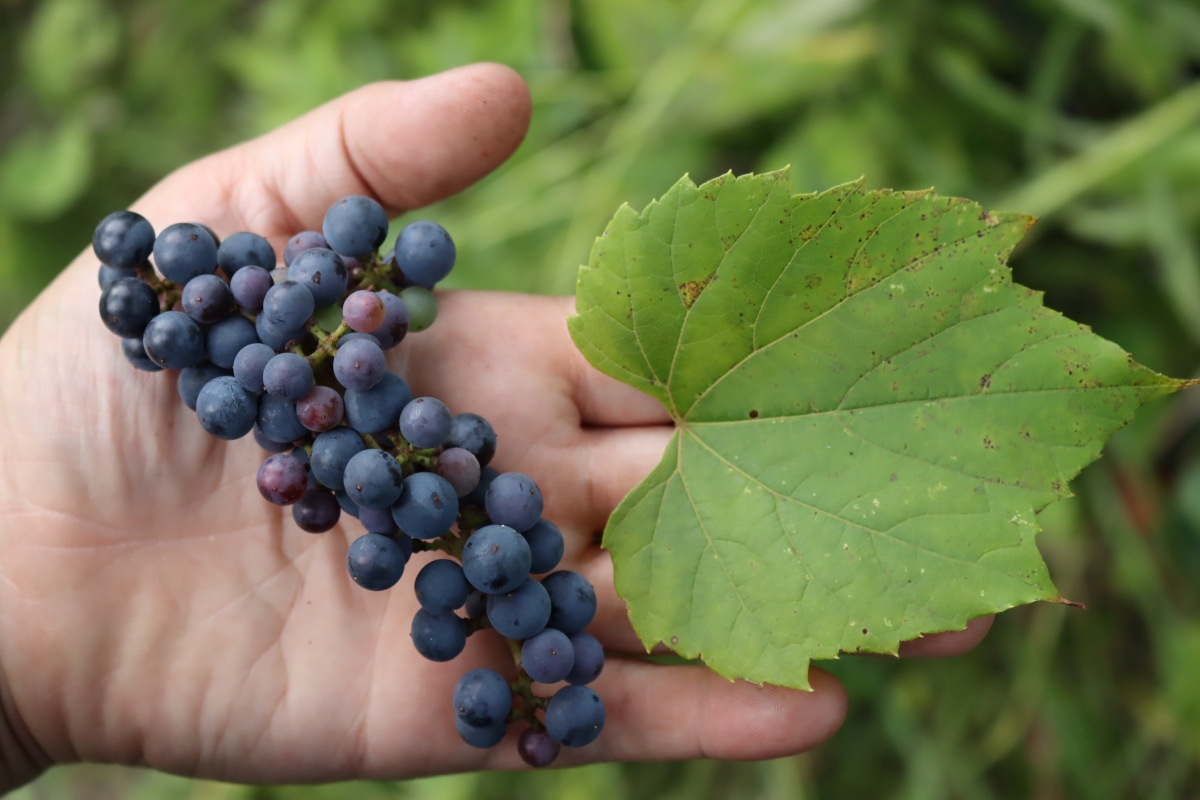
Wild grapes are an easy-to-identify wild edible fruit that grows just about everywhere in the US. They’re fun to pick, and before you know it, you can harvest them by the bucketload in rich areas.
They make wonderful juice, jelly, and wine, and the best part is, they’re absolutely free!
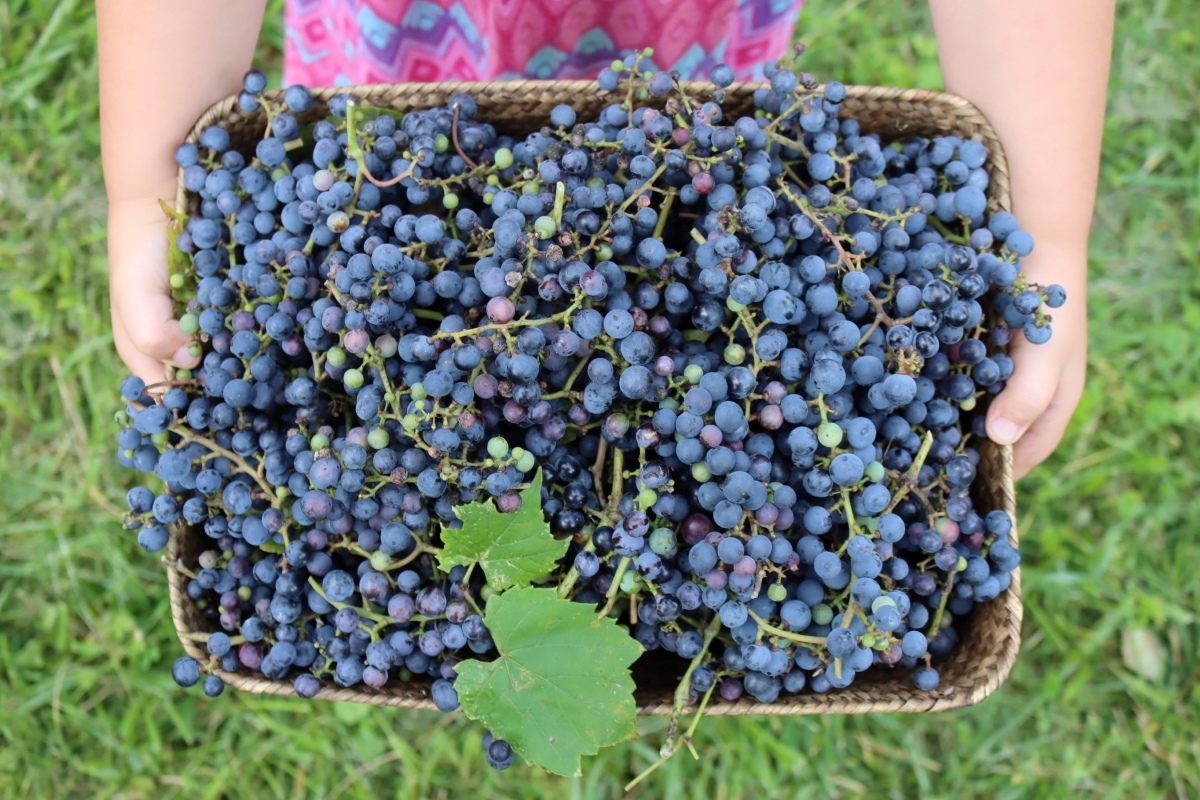
What are Wild Grapes?
Wild Grapes (Vitis sp.) are perennial woody vining plants in the Vitaceae or grape family. There are 79 Wild Grape species, most of which are native to the temperate regions of North America and eastern Asia. However, a few exceptions exist, like the Common Grape (Vitis vinifera), native to southern Europe and southwestern Asia.
Some Wild Grape species have become invasive outside of their native range. Even in areas where they are native, they can be aggressive. In areas where they are abundant, the vines may outcompete trees for sunlight or cause tree limbs to crack during winter storms with the extra weight.
Here in the Northeast, they’re likely to climb any fence they land near, covering it with fruit each autumn.
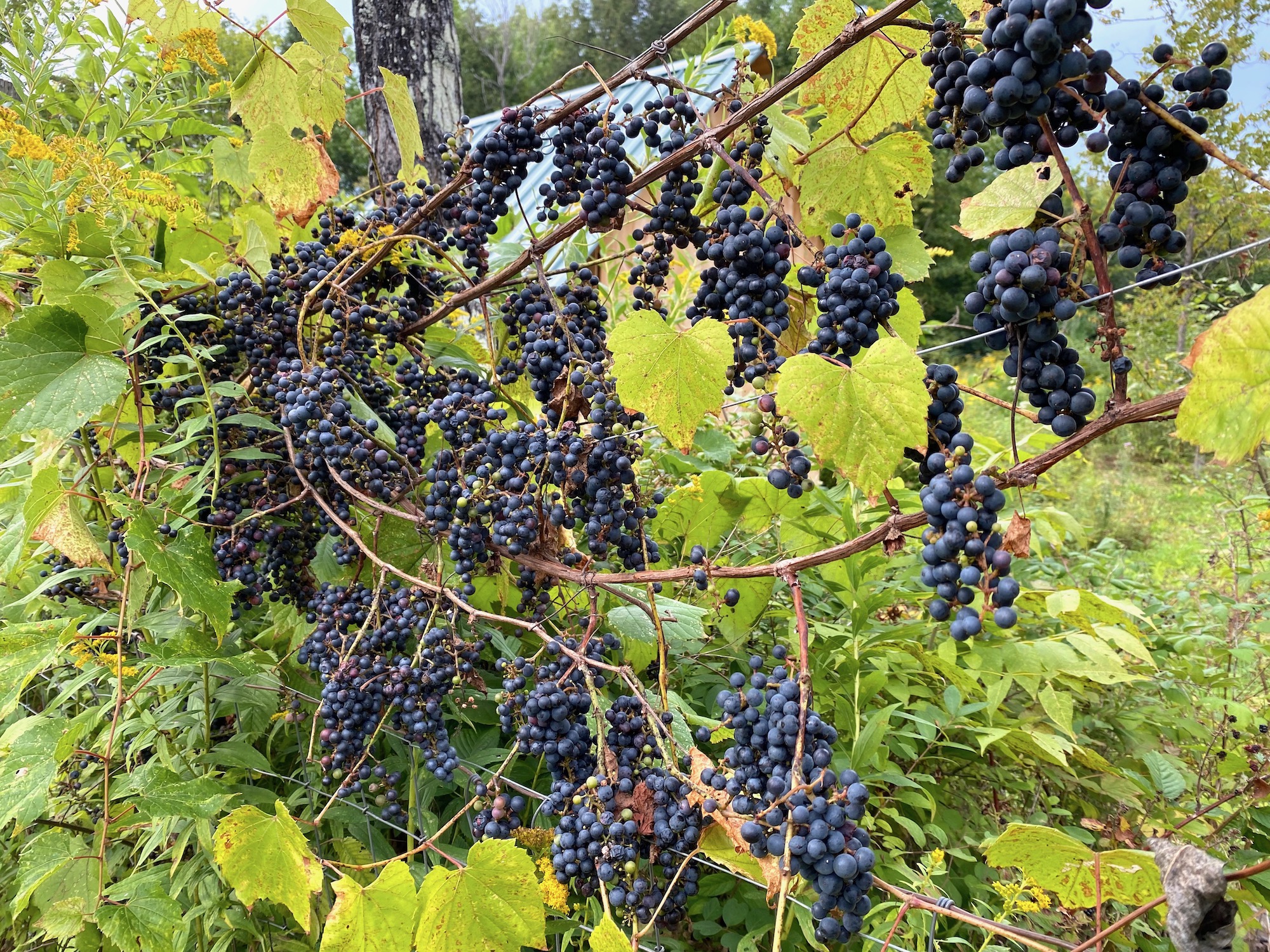
Are Wild Grapes Edible?
Yes, Wild Grapes are edible. Foragers often collect the grapes, which, though not as sweet, mild, and large as many cultivated grapes, are still tasty. You can use them in various recipes, raw, cooked, or fermented.
The leaves of all Wild Grapes are edible, but not all are choice. Young leaves, and those of certain species, are more tender and better tasting than others. You can eat them raw or cooked.
Wild Grapes also possess a myriad of pharmacological qualities. Herbalists frequently use the leaves for internal and external preparations.
Like domesticated grapes, Wild Grapes are toxic to dogs. Don’t share any of your harvest with your furry friends!
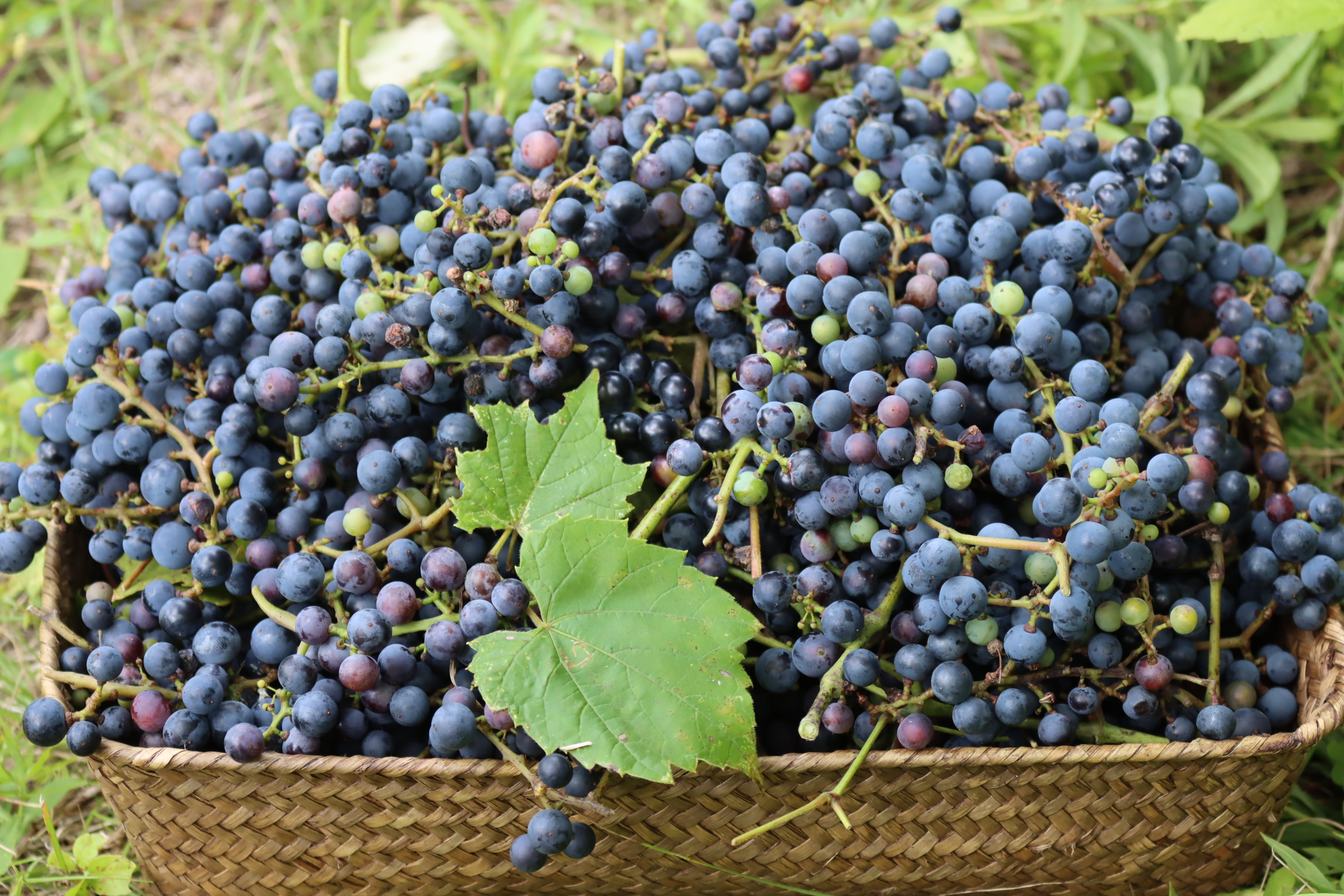
How Are Wild Grapes Different From Conventional Grapes?
While both are edible and have a similar growth habit, there are a few differences between wild grapes and cultivated grapes.
Cultivated grapes tend to be larger and sweeter than wild grapes, and are usually less acidic. They also usually have lower concentrations of tartaric acid (but not always).
Both wild and cultivated grapes can be vigorous and incredibly productive, and the actual yields per vine just depend on the specific plant and growing conditions. In many locations, wild grapes are more productive than their cultivated counterparts…even without pruning, fertilizer or care.
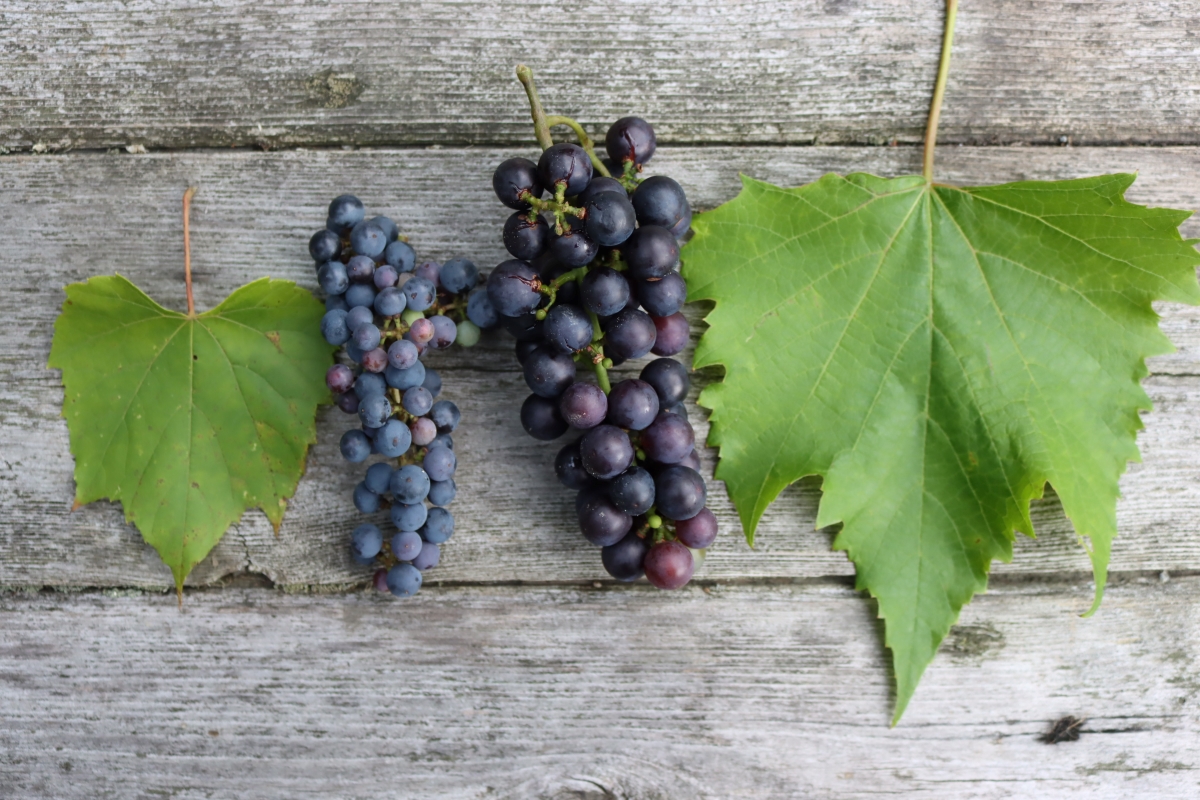
Wild Grape Medicinal Benefits
Wild Grapes are nutritional powerhouses and are full of essential vitamins, minerals, and antioxidants. Grapes are high in magnesium, potassium, and vitamins B1, B6, and C. Though often overlooked, the leaves contain significant amounts of iron, magnesium, and vitamins A, C, and E.
Wild Grapes also contain a chemical called resveratrol, which displays antioxidant, anti-inflammatory, immunomodulatory, glucose and lipid regulatory, neuroprotective, and cardiovascular protective effects. These qualities indicate to researchers that resveratrol and the foods containing it may help protect against chronic diseases such as Parkinson’s, Alzheimer’s, obesity, diabetes, cancer, liver diseases, and cardiovascular diseases.
Herbalists may also use the leaves internally and externally for treating various ailments. Internally, the leaves are made into tea for treating thrush, diarrhea, stomach, and hepatitis. Externally, the leaves are made into a poultice for treating headaches, sore chests, fevers, and rheumatism.
A modern look at the leaves suggests they possess significant antihyperglycaemic and antioxidant activity, which may help treat diabetes symptoms.
In the past, people also used wild grape wine for culinary, medicinal, and ritual purposes. Historically, many herbalists would muddle herbs in grape wine, similar to a tincture. These drinks were used as health tonics and to treat various illnesses, including heart problems, which may be due to grape’s resveratrol content.
Modern studies often focus on grape seeds and their extracts. Compounds within the seeds have been found to have significant anti-inflammatory effects. Several studies have also indicated that grapeseed extract treats chronic venous insufficiency that causes blood pooling in the legs. The extract may help ease symptoms, including varicose veins, fatigue, pain, and swelling.
There is also some evidence that grape seed extract may also help to treat edema, high cholesterol, and high blood pressure. Additionally, in laboratory studies, Grape seed extract helped slow the growth of breast, stomach, colon, prostate, and lung cancer cells.
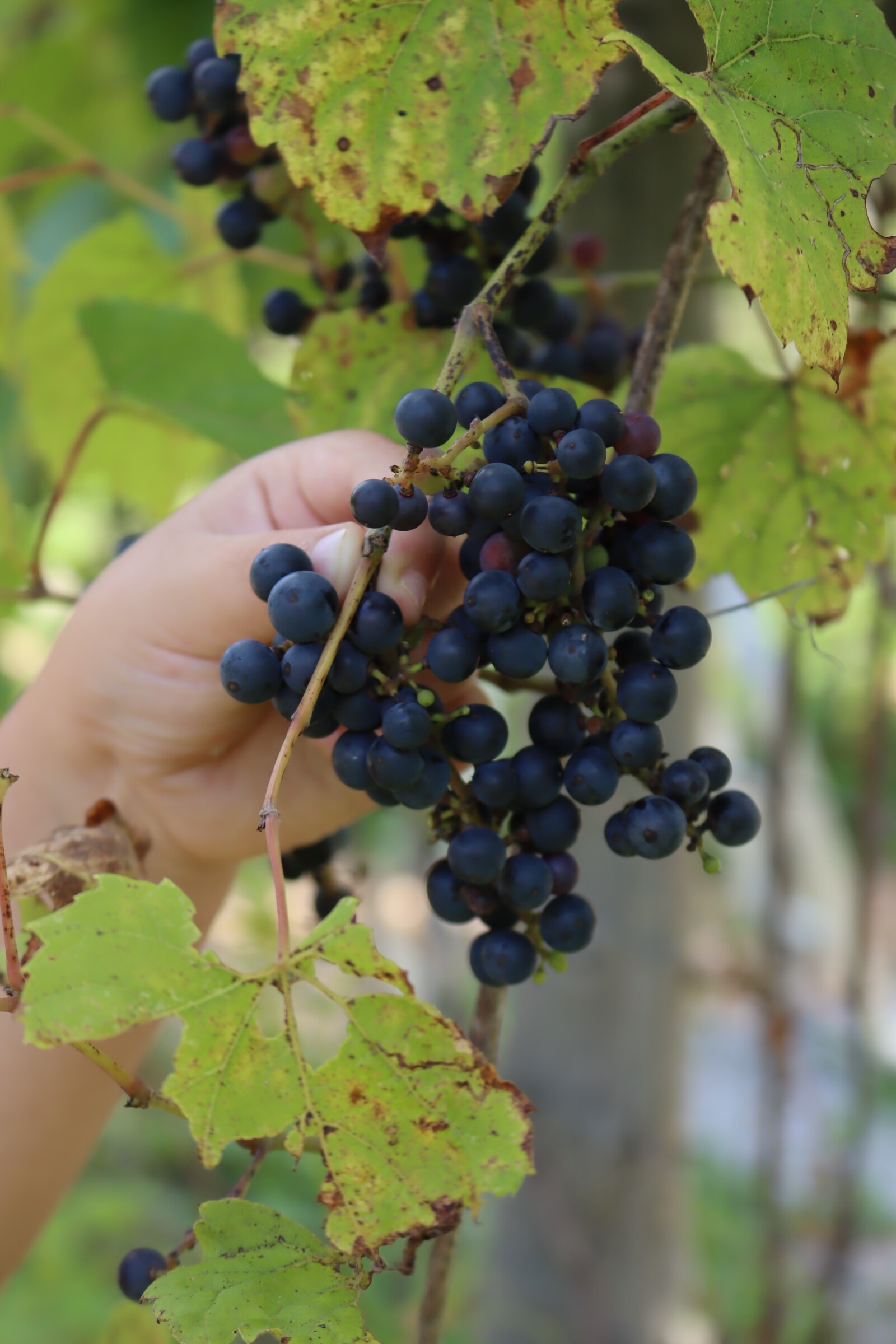
Where to Find Wild Grapes
Most Wild Grape species were originally native to North America, eastern Asia, and central Europe. Today, they are also invasive in some areas and have spread outside their native range to other temperate regions across the globe.
You’re likely to find Wild Grapes growing in disturbed areas, meadows, abandoned fields, within the forest interior, and along streams, riverbanks, and railways. The plants will grow within the shaded forest interior but fruit best when they get full sun.
Some species thrive only in rich, moist soils, while others grow well in dry sandy soils. Wild Grapes will tolerate various soil pH levels.
Really, they’ll grow just about anywhere a bird drops a seed, and they can find something that holds still long enough to climb.
When to Find Wild Grapes
Wild Grapes are perennial, deciduous plants; you may find them year-round on your woodland wanderings. The mature, shaggy, long vines hanging from the limbs of trees and shrubs can be spotted in the winter, but you’ll only spot the leaves in the summer.
The leaves emerge in spring and fall in autumn around the same time as maples, oaks, and other deciduous forest species. The leaves are best when picked in late spring or early summer.
Wild grape shoots are commonly eaten in some areas as an early spring green.
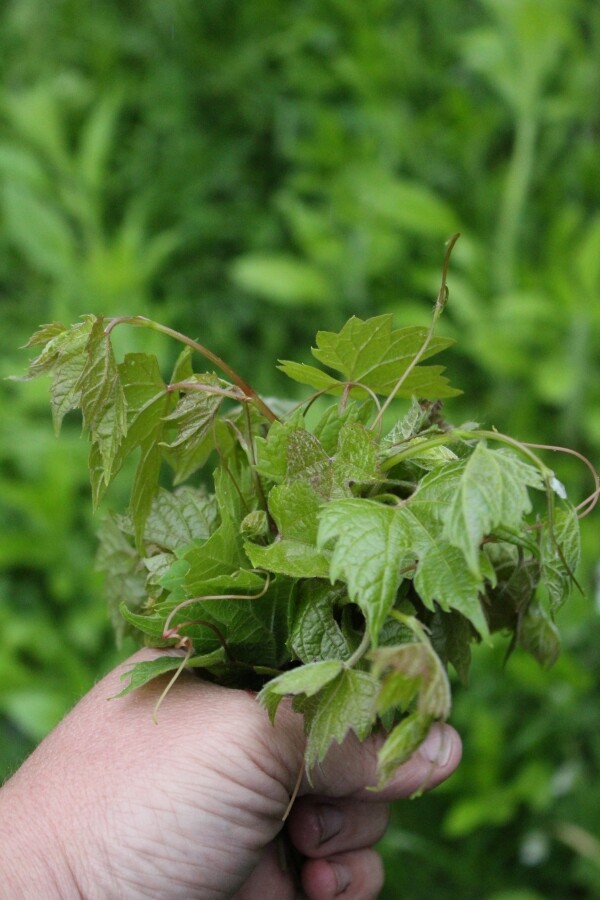
In early summer, if you look closely, you may spot inconspicuous clusters of tiny greenish flowers. These flower clusters give way to small, hard, green grapes, which slowly ripen and are ready for you to harvest in late summer or early fall.
The actual ripening time for wild grapes will vary by region and plant, and some will not ripen fully until around the first frost, while others are ready in August. Many types will hang on the plant all winter long, slowly freeze-drying in the cold weather…and ambitious foragers can harvest them mid-winter.
Identifying Wild Grapes
The large vining plants are typically easy to spot once you know what you’re looking for. They usually grow on other trees and shrubs, sometimes outcompeting them for sunlight. Their large, veined leaves are green except in the fall when they turn color with other foliage.
Wild grape vines grow thick and long. In dense mature forests, the lower portions of the vines may be all you see, with the leaves and grapes forming in the forest canopy’s sunlight.
Wild Grape flowers tend to be hard to spot. They’re clusters of tiny greenish flowers. When the grapes are ripe, they are easy to recognize. They’re generally smaller but don’t look that different from grapes you’d find in the grocery store. However, they sometimes grow too high in the trees to be seen.
Wild Grape Leaves
Grapes have simple, palmate, alternate leaves with toothed margins. They’re typically green above and often paler and hairy below with prominent veins. Wild Grape leaves are usually 2 to 9 inches long, about 4 inches wide, and variable in shape, even on a single plant.
They may be unlobed or feature 3 to 5 deep lobes. Wild Grape leaves may change to yellow, red, orange, or purplish in the autumn before falling.
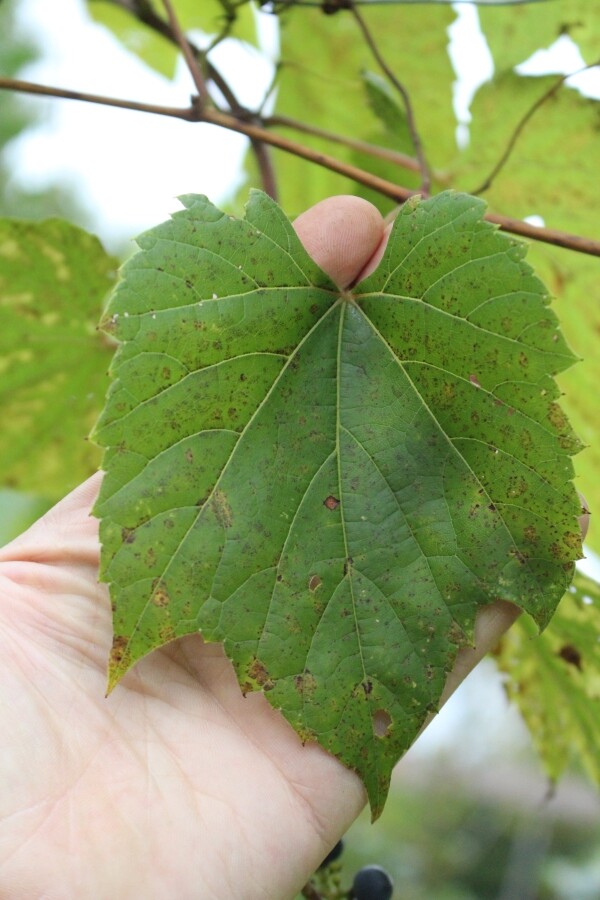
Wild Grape Stems
Wild Grape vines often reach 50 feet long and can grow to 100 feet or more. Older, mature vines may grow to about 6 inches in diameter.
The vines use other trees, shrubs, and structures to reach up into the canopy. Large stems have brown, shaggy, shedding bark. Younger stems are darker in color and can be hairy in some species.
The stems also have small spiraling tendrils opposite of the leaves, which help the vines climb and hold on to things.
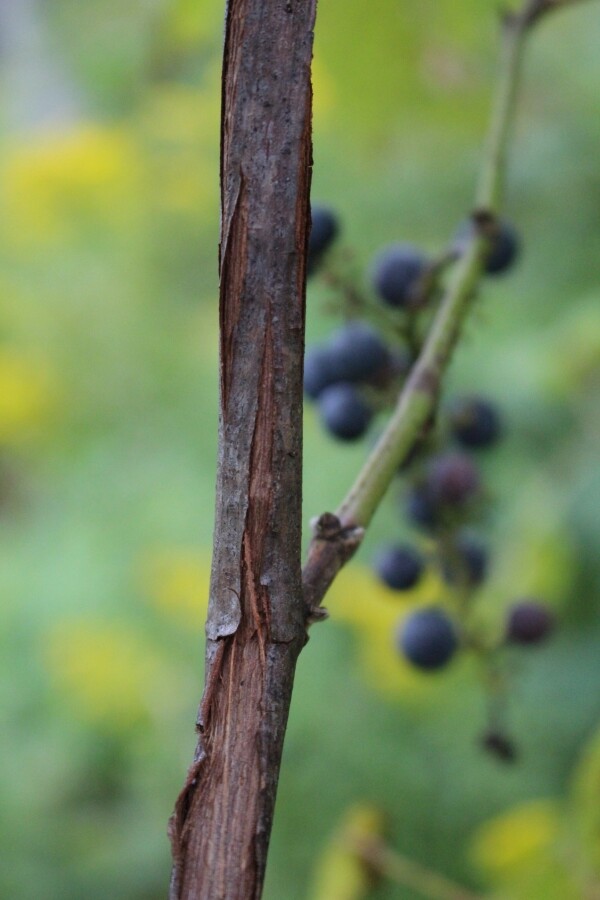
Wild Grape Flowers
Wild Grapes produce 2 to 6-inch panicles or branching clusters of small, inconspicuous greenish flowers. Typically, the plants bloom between May and July, depending on the species and location.
Unlike cultivated grapes, most wild grape species are dioecious, meaning they have separate male and female plants.
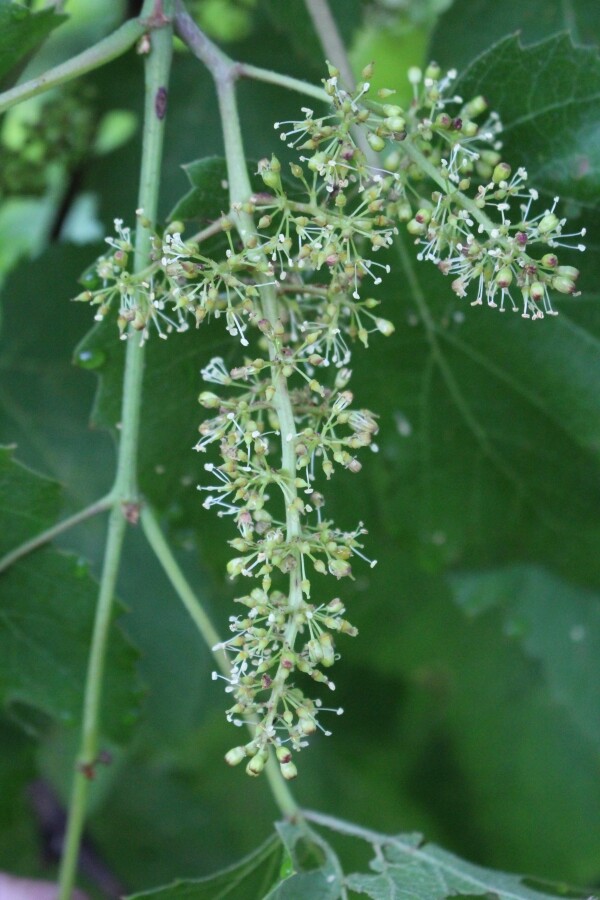
Wild Grape Fruit
The flower clusters give way to tiny green, hard grapes. These grapes slowly grow and ripen. Most species ripen to purplish, dark blue, or blackish.
When ripe, the grapes are generally smaller and more spherical than many cultivated varieties. They typically range from ⅛ to 1 inch in diameter. Their flavor varies but is generally a bit tart and citrusy.
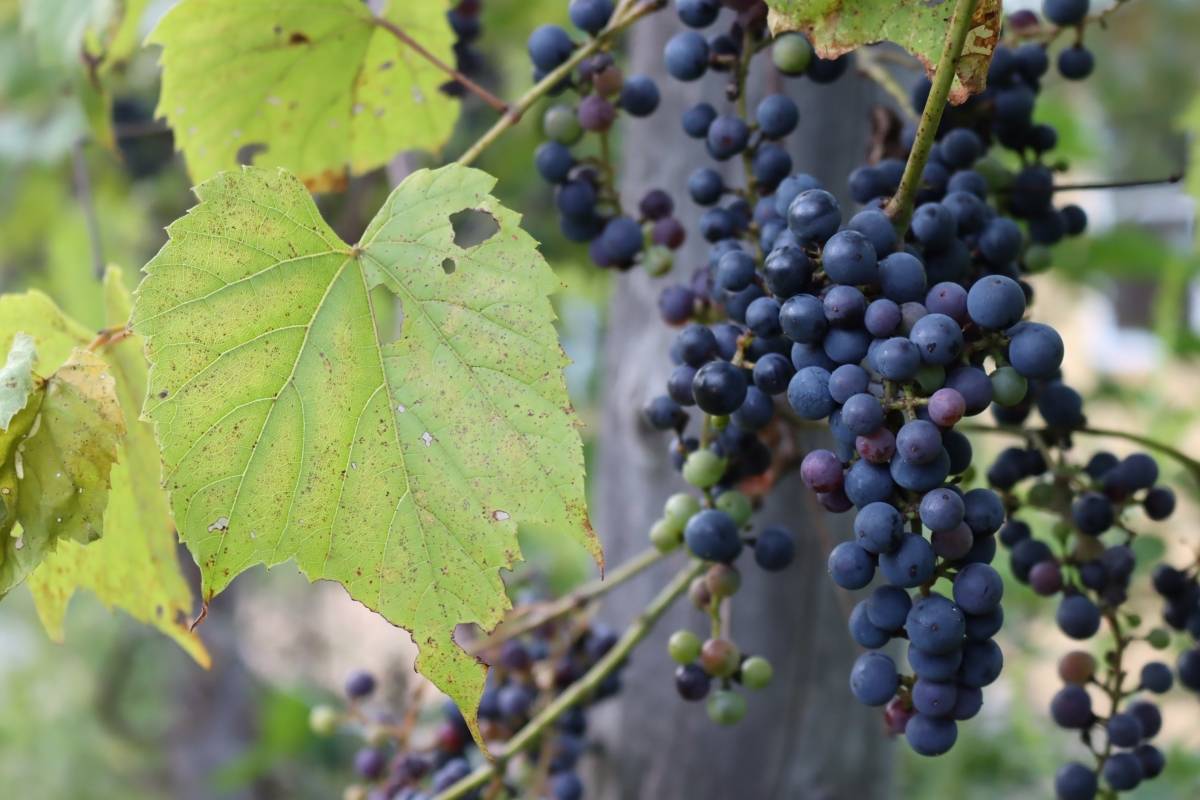
Wild Grape Look-Alikes
Wild grapes are sometimes mistaken for toxic Moonseed (Menispermum canadense). However, Moonseed differs in a couple of easy-to-spot ways:
- Moonseed leaves are lobed but have smooth, non-toothed margins.
- Moonseed vines tend to be smaller, only reach about 20 feet in height, and lack the curling tendrils present on grape vines.
- Moonseed seeds are shaped like a partial disc or crescent moon with a bowl or depression in the center.
Another look-alike is Virginia creeper (Parthenocissus quinquefolia). However, it too differs in a few noticeable ways:
- Virginia Creeper leaves are palmately compound and composed of three to usually five leaflets.
- Virginia Creeper berries are hard even when ripe, purple to black, and are small, only about 3⁄16 to 1⁄4 inches in diameter.
- The tendrils on Virginia Creeper vines have adhesive pads at the ends, which help the plant adhere to bark, buildings, and other surfaces.
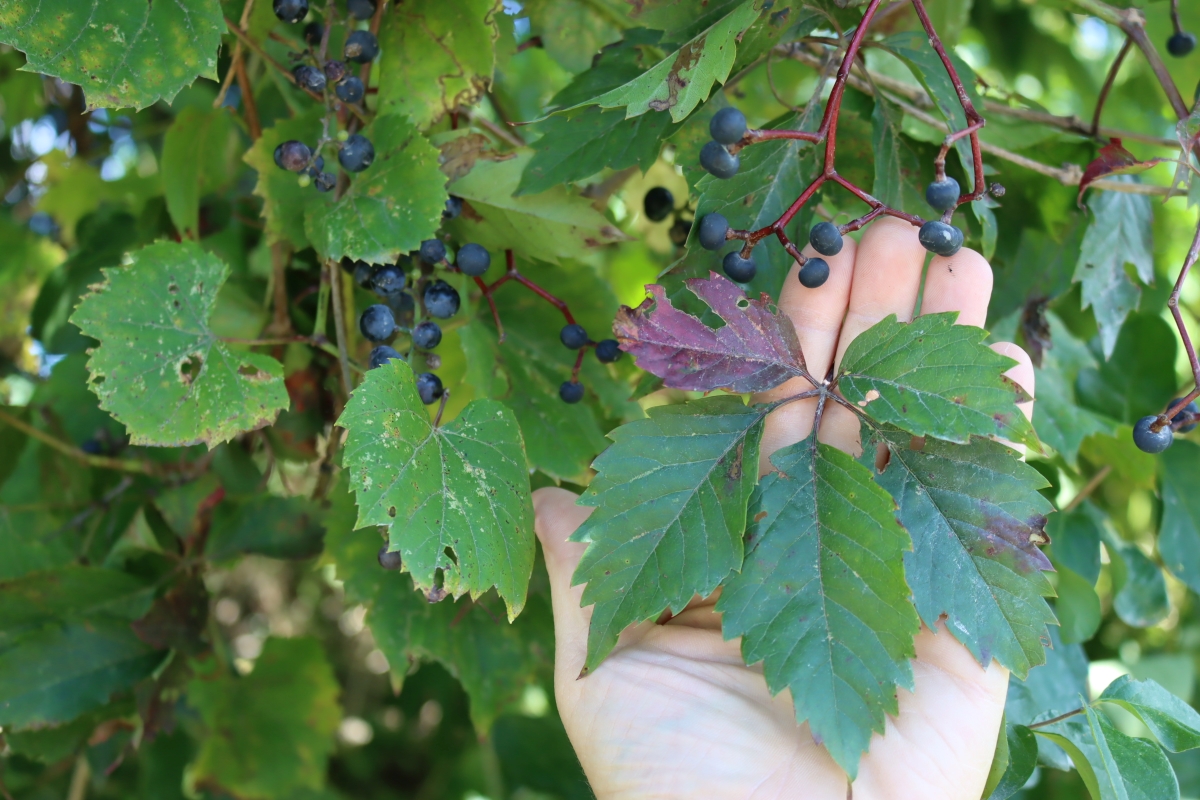
Wild grapes can sometimes be mistaken for toxic Pokeberry or American Pokeweed (Phytolacca americana), especially by young children who may focus on the clusters of dark berries. Pokeberry can be distinguished from wild grapes in the following ways:
- Pokeberry is a shrubby, herbaceous plant that grows up to 10 feet tall.
- Pokeberry has simple leaves that have smooth margins and are lanceolate in shape and tapered at both ends.
- Pokeberry’s dark purple berries ripen on bright pink racemes or stalks.
Lastly, Sarah from Root’s School mentioned to me that in one of her foraging classes, a student freely harvested toxic buckthorn (Rhamnus davurica) along with wild grape into the same basket. Buckthorn is common and invasive, and wild grapes often grow up these shrub-like trees.
They have round fruit that are roughly the same size and shape as grapes, but they don’t come in clusters, and they’re on a tree. Just be careful if you’re harvesting wild grapes growing in buckthorn.
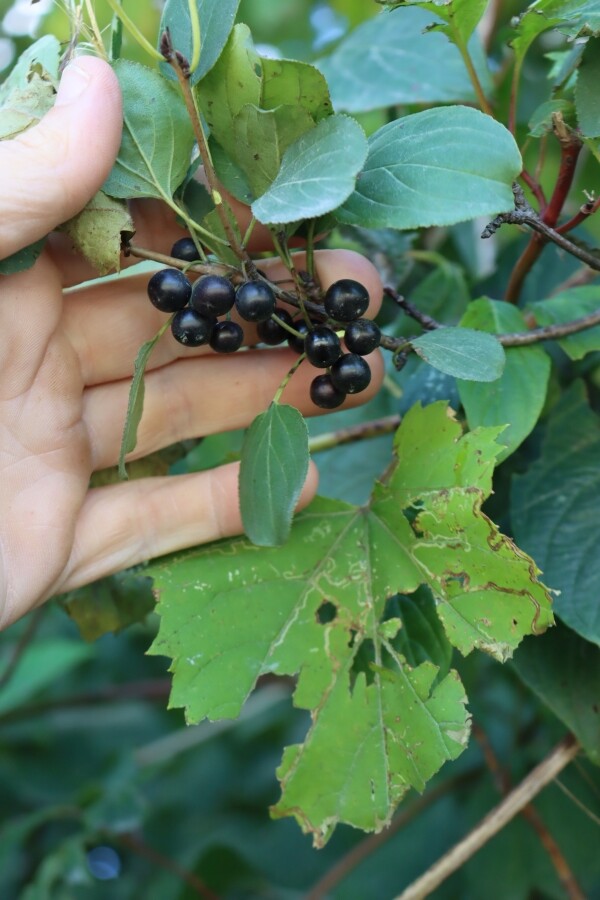
Lastly, I’ve occasionally seen people in online groups misidentify wild grape with all manner of other dark-colored fruits. Everything from aronia to nannyberry, and other fruits that grow on bushes or trees. The fruit don’t look really anything alike, and neither do the plants. Just be sure you have a grapevine!
Processing Wild Grapes
The main thing to note about using wild grapes is they tend to have substantially more tartaric acid than regular grapes. Some varieties of cultivated grapes also have high levels, and so it’s not universal.
Tartaric acid forms crystals that can be irritating to your mouth and throat, so it may not be a great idea to eat wild grapes fresh in the field.
The best way to remove tartaric acid is to juice the grapes, either by pressing or simmering, and then refrigerating the juice overnight. The tartaric acid crystals will precipitate out of the juice when refrigerated, and you can easily pour off the cleaned juice through a layer of cheesecloth.
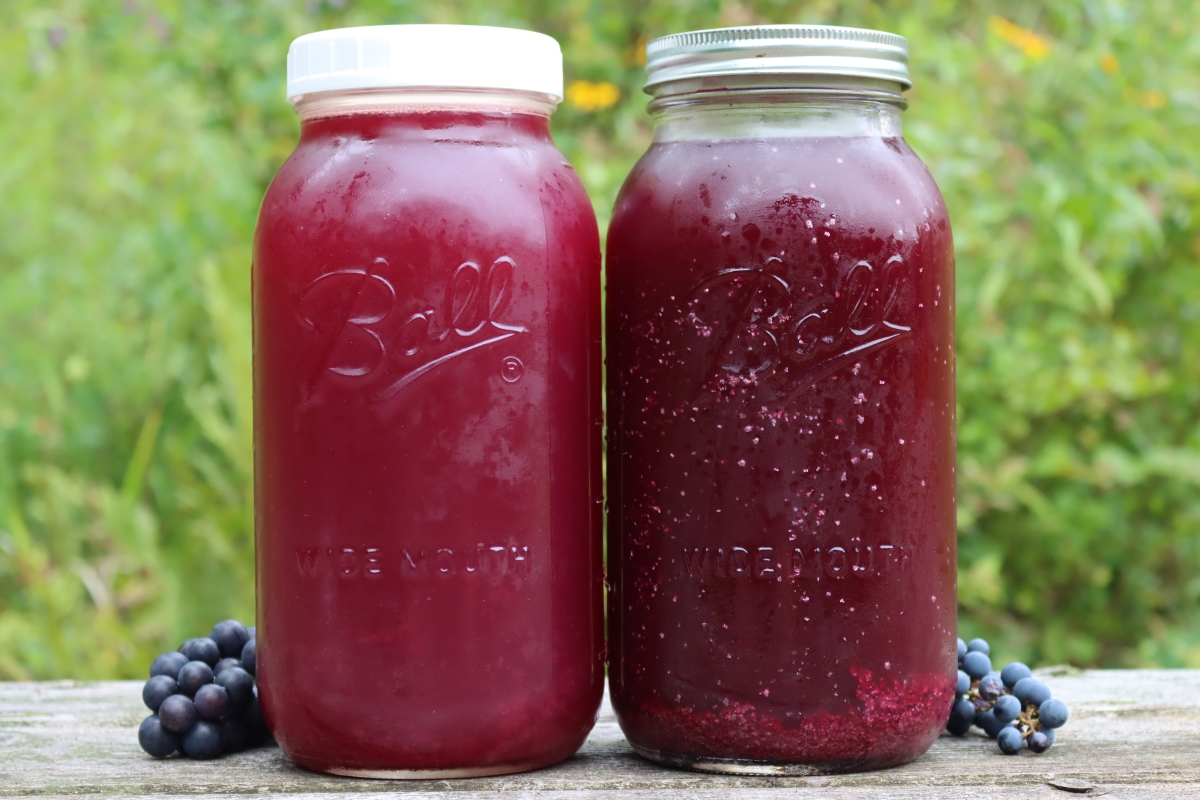
Every single wild grape plant will be a bit different in both flavor and tartaric acid content. The ones we have around our homestead tend to have quite a bit of tartaric acid, and I’ll pull about 1/4 to 1/2 cup of crystals from a half-gallon jar.
Believe it or not, this same tartaric acid can be processed into cream of tartar if you’re ambitious. It’s a baking ingredient that’s made by washing and then powdering tartaric acid from grapes.
It’s used as an acid source to react with baking soda in recipes, but it’s also used to keep egg whites nice and fluffy in meringues, among other things.
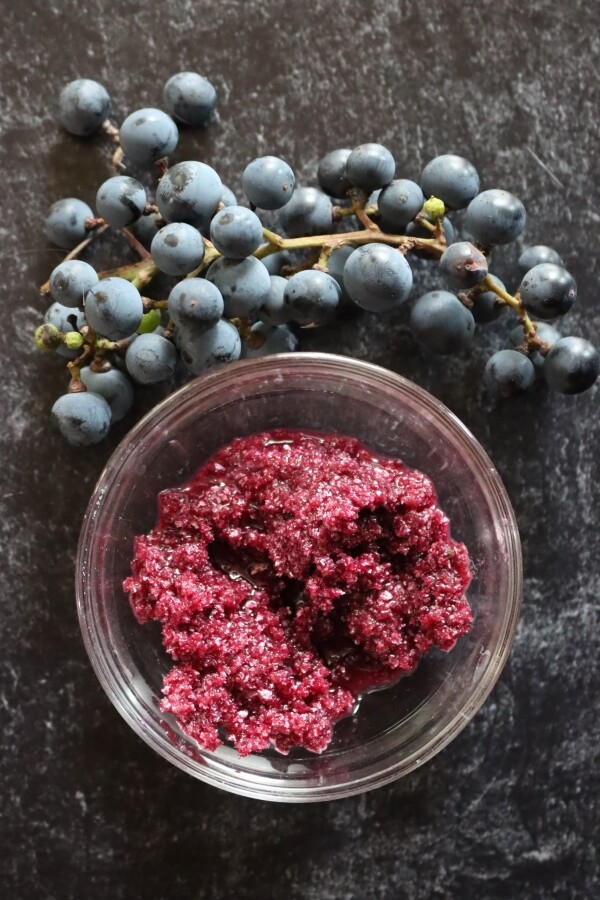
Ways to Use Wild Grapes
Wild grapes are often overlooked in favor of their cultivated, grocery-store counterparts, but these easy-to-recognize wild edibles are tasty, healthy, and free! You can use them to make jam, preserves, desserts, and juice.
If you’re up for a project, try fermenting your own wild grape wine. The process isn’t all that different from making grape wine in general, but you will need to add some sugar since the fruit is not nearly as sweet as wine grapes. I’d suggest about 2 pounds of sugar per gallon of grape juice to start.
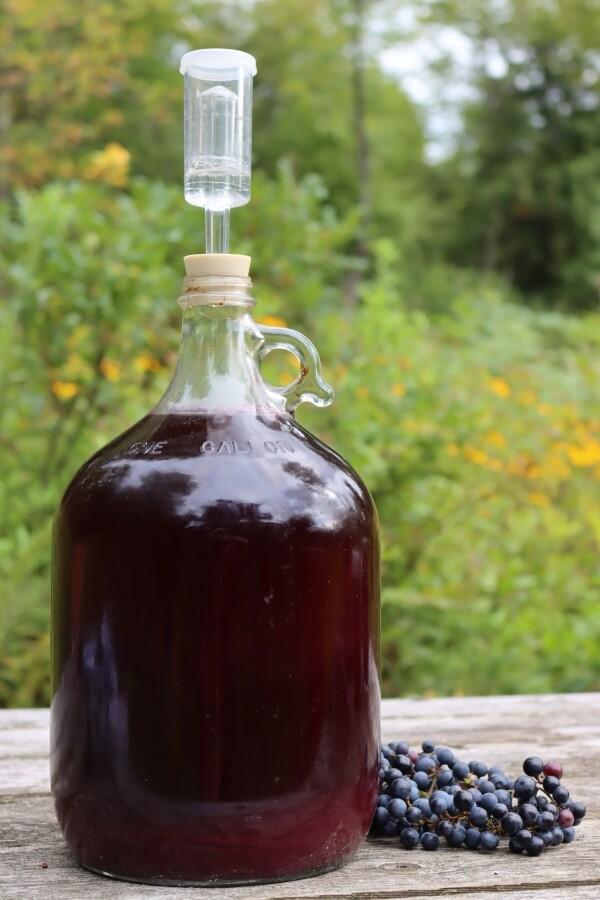
The leaves are also nutritious and tasty. Grab some in early summer for making your own sauteed greens, stuffed grape leaves, salad, pilaf, or pesto. They also make a great inner cover for traditional cucumber pickles and other vegetable ferments.
If you’re an herbalist, you can also use grape leaves and seeds in your herbal medicine practice. For internal use, try making grape leaf tea for stomach problems. Externally, you can use the leaves as a poultice for headaches, sore chests, and other body pain.
To use the seeds, strain or mill them out of the grapes (you can use the grapes and their juice to make jelly) and then tincture them. Grape seed tincture may help improve circulation and treat inflammation, high cholesterol, and high blood pressure.
In the summer, wild grape vines are also full of water, which is safe to drink in a survival situation.
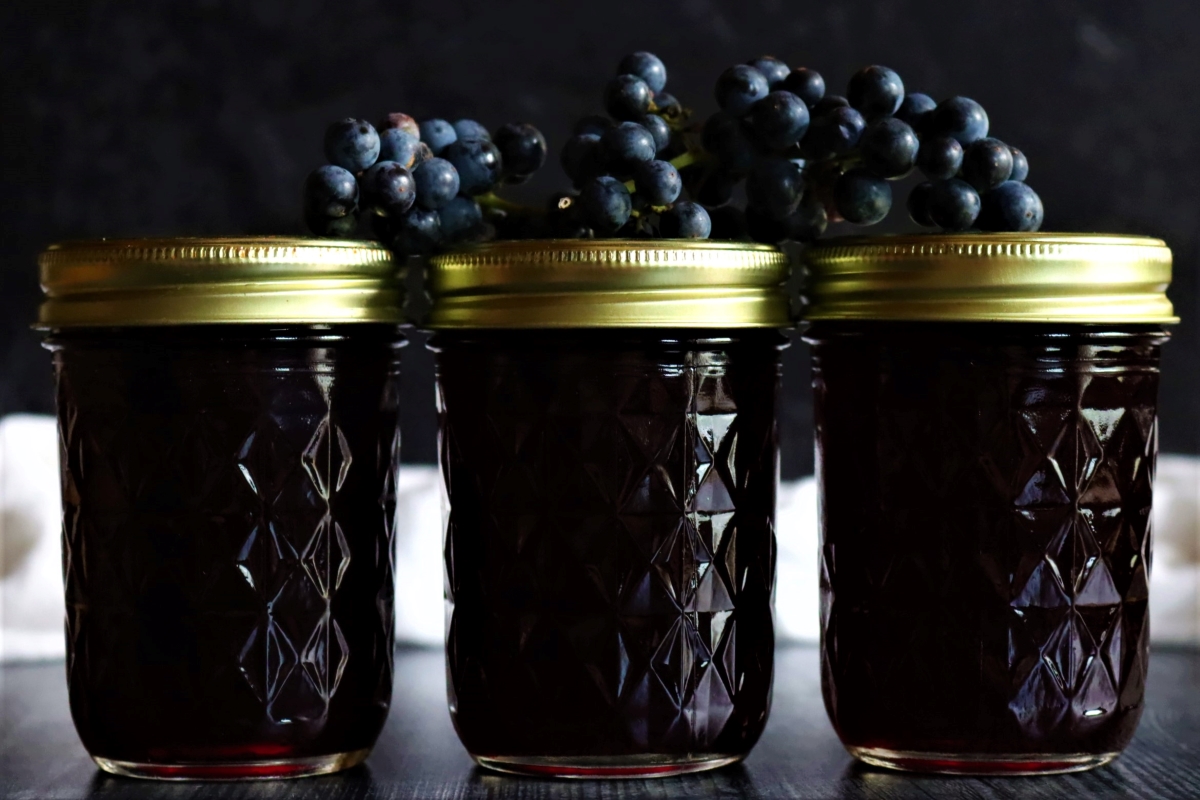
Wild Grape Recipes
Looking for ways to use wild grapes?
- Preserve your wild grapes with my easy wild grape jelly recipe!
- Put a new twist on grapes with this Spicy Wild Grape Barbecue Sauce recipe from the Forager Chef.
- Create a sweet foraged treat for friends and family with this Wild Grape Chiffon Cake from Edible Wild Food.
- Make the best of summer and your foraged harvest with this Wild Grape Sorbet from Food52.
- Got grape leaves? Make these classic Greek Dolmades (stuffed grape leaves) with this simple recipe from Hunt Gather Cook.
- Get the flavor of delicious Greek stuffed grape leaves in just 30 minutes with this recipe for Grape Leaf Pilaf: Greek Deconstructed Dolamdakia from Dimitras Dishes.
- Preserve extra grape leaves while they’re in season with this Pickled Grape Leaves recipe from the Forager Chef.
Fruit Foraging Guides
Looking for more foraging guides? I have literally dozens of identification guides for wild berries and fruits…
- Foraging Nannyberry
- Foraging Highbush Cranberry
- Foraging Chokecherry
- Foraging Autumn Olive
- Foraging Serviceberry
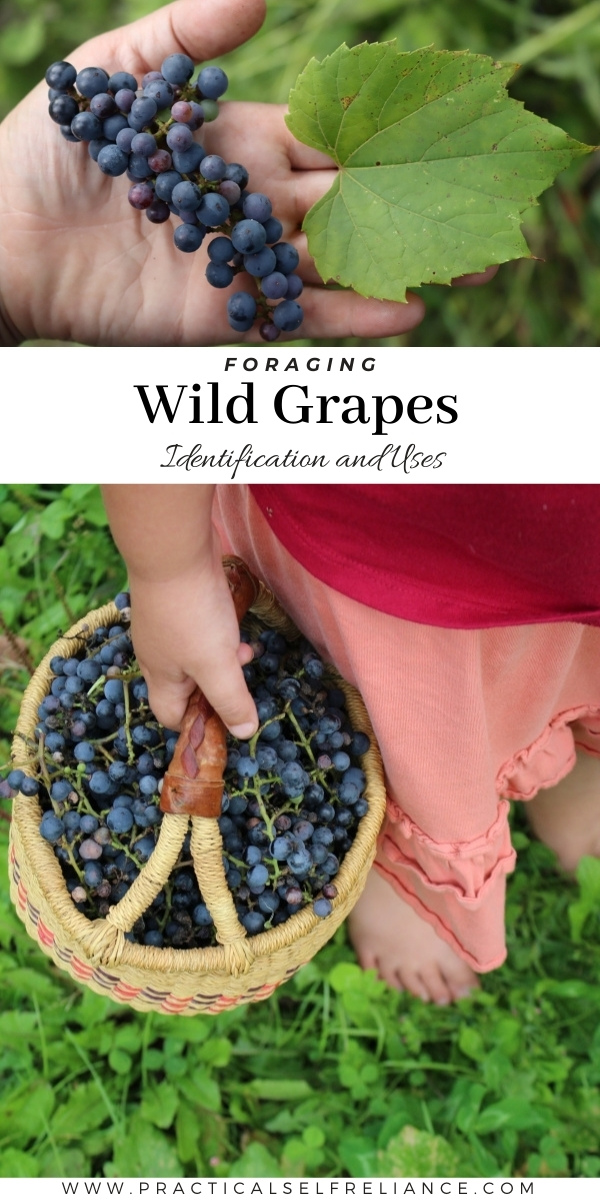
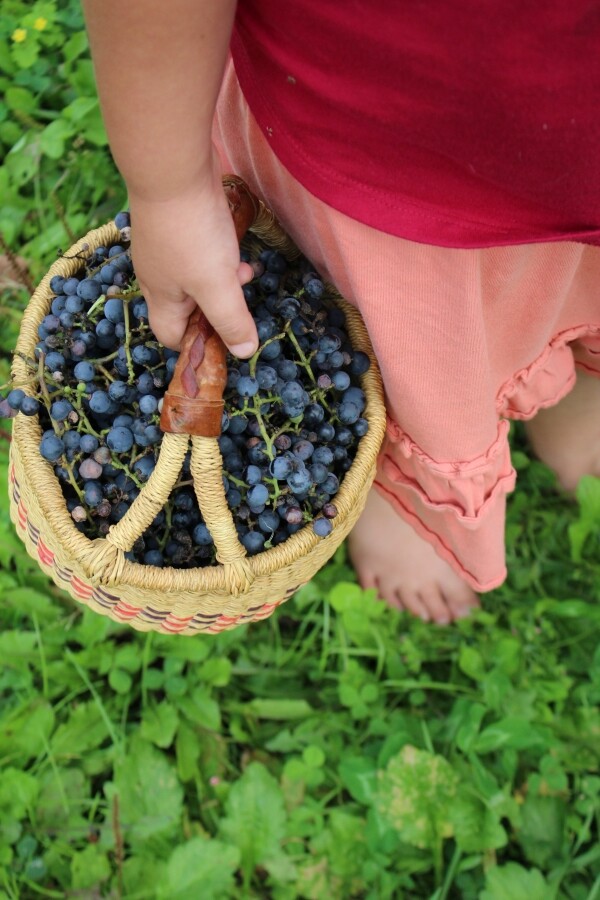














I just want to say thank you so much. Your articles are very informative. I am just learning here and your articles are about the best that I have found. I had found Muscadine grapes growing on the property here, but have not looked to see what else may be here. Ready to explore. I did find Poke weed at the far end of the property a few years ago and last year it had managed to pop up in my front yard. I am trying to get rid of it!!! Not easy. 🙂 Once again, thank you very much!
Poke weed is pretty rare around here, but there are a lot of southern recipes for eating the shoots in the early spring. While the fruit is toxic, the shoots are edible (if you process them right)…and people used to harvest and can the greens and shoots for export. That’s one way to get rid of them!
Thank you very much. I will look into processing the shoots for next year. I have cut down all of the current plants to try to keep the fruit from spreading more. seeds around They seem to be basically invasive here. We had NONE at the house for 6 years, but they were at the other end of a forty acre stretch and all of a sudden showed up at the house. My guess is that the birds dropped the seeds here.
I’ve made wild grape pie twice! It’s a lot of work separating the seeds, but it’s a fun activity to do with kids or friends. https://m.sevendaysvt.com/BiteClub/archives/2014/10/14/farmers-market-kitchen-wild-grape-pie.
Just made a 1/2 gallon of grape juice with fruit from a single, vigorous vine–it is, like you said, such a free gift. Thanks for the helpful information–you’re one of the few foragers online I actually trust, since you actually do what you talk about. Happy fall to you!
Thank you so much Wren, and I’m so happy about your find!